Short-Interval, Severe Wildfires Alter Saproxylic Beetle Diversity in Andean Araucaria Forests in Northwest Chilean Patagonia
Abstract
:1. Introduction
2. Materials and Methods
2.1. Study Area
2.2. Fire Regimes in TNP and CMNRs Parks
2.3. Sampling Method and Field Design
2.4. Ecological Variables
- -
- Arboreal density (arboreal_D, continuous). We registered all standing dead and living trees with diameter ≥5 cm in each selected plot. The data were extrapolated to hectare.
- -
- Dead wood volume (dead_vol, continuous). In each sampling plot, we registered all woody debris on the ground (logs) with diameter ≥10 cm, and all the dead tree branches with stem diameter ≥10 cm and length ≥2 m. For each log or branch registered, we recorded total length (m), and diameter (cm) at the base and top. Additionally, we recorded the diameter at breast height (dbh) and total height of each standing dead and living tree with diameter ≥5. To estimate the wood volume, a cylindrical shape was assumed for each piece. Finally, the data was extrapolated to hectare (see Supplementary Material S1).
- -
- Diameter (dbh_WT, continuous). The dbh of each tree where the traps were installed.
- -
- -
- Burned area (burn_WT: five categories 0–4; categorical). We estimated the burned area (i.e., carbonized area) of each trap tree, considering: 0, unburned; 1, ≥1 to 25%; 2, ≥26 to 50%; 3, ≥51 to 75%; 4, ≥76% to 100% burned area.
- -
- Bark cover (bark_WT: presence or absence, categorical). We consider two categories of bark cover: present, when the trunk is covered by bark on at least 75% of its total surface; absent, when the bark is absent from at least 75% of its total surface.
2.5. Data Analysis
3. Results
3.1. Saproxylic Beetle Catch
3.2. Diversity Patterns
3.3. Partition of Beta-Diversity
3.4. Trophic Guilds Response
3.5. Influence of Environmental Variables on Diversity Patterns
4. Discussion
4.1. Impacts of Post-Fire Habitat Conditions on Saproxylic Beetles Diversity
4.2. Saproxylic Diversity Pattern Induced by Burned Conditions
4.3. Trophic Guild Responses to Burned Conditions
4.4. Implication of SISF for the Diversity and Conservation of Saproxylic Beetles and Forest Management
5. Conclusions
Supplementary Materials
Author Contributions
Funding
Institutional Review Board Statement
Informed Consent Statement
Data Availability Statement
Acknowledgments
Conflicts of Interest
References
- Westerling, A.L. Warming and Earlier Spring Increase Western U.S. Forest Wildfire Activity. Science 2006, 313, 940–943. [Google Scholar] [CrossRef] [PubMed] [Green Version]
- Jolly, W.M.; Cochrane, M.A.; Freeborn, P.H.; Holden, Z.A.; Brown, T.J.; Williamson, G.J.; Bowman, D.M.J.S. Climate-Induced Variations in Global Wildfire Danger from 1979 to 2013. Nat. Commun. 2015, 6, 7537. [Google Scholar] [CrossRef] [PubMed]
- Littell, J.S.; Peterson, D.L.; Riley, K.L.; Liu, Y.; Luce, C.H. A Review of the Relationships between Drought and Forest Fire in the United States. Glob. Chang. Biol. 2016, 22, 2353–2369. [Google Scholar] [CrossRef]
- Turco, M.; Von Hardenberg, J.; AghaKouchak, A.; Llasat, M.C.; Provenzale, A.; Trigo, R.M. On the Key Role of Droughts in the Dynamics of Summer Fires in Mediterranean Europe. Sci. Rep. 2017, 7, 81. [Google Scholar] [CrossRef] [Green Version]
- Dennison, P.E.; Brewer, S.C.; Arnold, J.D.; Moritz, M.A. Large Wildfire Trends in the Western United States, 1984–2011. Geophys. Res. Lett. 2014, 41, 2928–2933. [Google Scholar] [CrossRef]
- He, T.; Lamont, B.B.; Pausas, J.G. Fire as a Key Driver of Earth’s Biodiversity. Biol. Rev. 2019, 94, 1983–2010. [Google Scholar] [CrossRef]
- Donato, D.C.; Fontaine, J.B.; Campbell, J.L. Burning the Legacy? Influence of Wildfire Reburn on Dead Wood Dynamics in a Temperate Conifer Forest. Ecosphere 2016, 7, e01341. [Google Scholar] [CrossRef] [Green Version]
- Harvey, B.J.; Donato, D.C.; Turner, M.G. Burn Me Twice, Shame on Who? Interactions between Successive Forest Fires across a Temperate Mountain Region. Ecology 2016, 97, 2272–2282. [Google Scholar] [CrossRef] [PubMed]
- Paine, R.T.; Tegner, M.J.; Johnson, E.A. Compounded Perturbations Yield Ecological Surprises. Ecosystems 1998, 1, 535–545. [Google Scholar] [CrossRef]
- Turner, M.G. Disturbance and Landscape Dynamics in a Changing World. Ecology 2010, 91, 2833–2849. [Google Scholar] [CrossRef] [Green Version]
- Millar, C.I.; Stephenson, N.L. Temperate Forest Health in an Era of Emerging Megadisturbance. Science 2015, 349, 823–826. [Google Scholar] [CrossRef] [PubMed]
- Turner, M.G.; Braziunas, K.H.; Hansen, W.D.; Harvey, B.J. Short-Interval Severe Fire Erodes the Resilience of Subalpine Lodgepole Pine Forests. Proc. Natl. Acad. Sci. USA 2019, 116, 11319–11328. [Google Scholar] [CrossRef] [Green Version]
- Bowman, D.M.J.S.; Balch, J.K.; Artaxo, P.; Bond, W.J.; Carlson, J.M.; Cochrane, M.A.; D’Antonio, C.M.; Defries, R.S.; Doyle, J.C.; Harrison, S.P.; et al. Fire in the Earth System. Science 2009, 324, 481–484. [Google Scholar] [CrossRef]
- Donato, D.C.; Fontaine, J.B.; Robinson, W.D.; Kauffman, J.B.; Law, B.E. Vegetation Response to a Short Interval between High-Severity Wildfires in a Mixed-Evergreen Forest. J. Ecol. 2009, 97, 142–154. [Google Scholar] [CrossRef] [Green Version]
- Fairman, T.A.; Bennett, L.T.; Nitschke, C.R. Short-Interval Wildfires Increase Likelihood of Resprouting Failure in Fire-Tolerant Trees. J. Environ. Manag. 2019, 231, 59–65. [Google Scholar] [CrossRef] [PubMed]
- Meng, R.; Dennison, P.E.; D’Antonio, C.M.; Moritz, M.A. Remote Sensing Analysis of Vegetation Recovery Following Short-Interval Fires in Southern California Shrublands. PLoS ONE 2014, 9, e110637. [Google Scholar] [CrossRef] [Green Version]
- Beale, C.M.; Courtney Mustaphi, C.J.; Morrison, T.A.; Archibald, S.; Anderson, T.M.; Dobson, A.P.; Donaldson, J.E.; Hempson, G.P.; Probert, J.; Parr, C.L. Pyrodiversity Interacts with Rainfall to Increase Bird and Mammal Richness in African Savannas. Ecol. Lett. 2018, 21, 557–567. [Google Scholar] [CrossRef] [Green Version]
- Carbone, L.M.; Tavella, J.; Pausas, J.G.; Aguilar, R. A Global Synthesis of Fire Effects on Pollinators. Glob. Ecol. Biogeogr. 2019, 28, 1487–1498. [Google Scholar] [CrossRef]
- Griffiths, A.D.; Garnett, S.T.; Brook, B.W. Fire Frequency Matters More than Fire Size: Testing the Pyrodiversity-Biodiversity Paradigm for at-Risk Small Mammals in an Australian Tropical Savanna. Biol. Conserv. 2015, 186, 337–346. [Google Scholar] [CrossRef]
- Fontaine, J.B.; Donato, D.C.; Robinson, W.D.; Law, B.E.; Kauffman, J.B. Bird Communities Following High-Severity Fire: Response to Single and Repeat Fires in a Mixed-Evergreen Forest, Oregon, USA. For. Ecol. Manag. 2009, 257, 1496–1504. [Google Scholar] [CrossRef] [Green Version]
- Moretti, M.; Obrist, M.K.; Duelli, P. Arthropod Biodiversity after Forest Fires: Winners and Losers in the Winter Fire Regime of the Southern Alps. Ecography 2004, 27, 173–186. [Google Scholar] [CrossRef]
- Coop, J.D.; Parks, S.A.; Mcclernan, S.R.; Holsinger, L.M. Influences of Prior Wildfires on Vegetation Response to Subsequent Fire in a Reburned Southwestern Landscape. Ecol. Appl. 2016, 26, 346–354. [Google Scholar] [CrossRef]
- Paritsis, J.; Veblen, T.T.; Holz, A. Positive Fire Feedbacks Contribute to Shifts from Nothofagus pumilio Forests to Fire-Prone Shrublands in Patagonia. J. Veg. Sci. 2015, 26, 89–101. [Google Scholar] [CrossRef]
- Cochrane, M.A.; Alencar, A.; Schulze, M.D.; Souza, C.M.; Nepstad, D.C.; Lefebvre, P.; Davidson, E.A. Positive Feedbacks in the Fire Dynamic of Closed Canopy Tropical Forests. Science 1999, 284, 1832–1835. [Google Scholar] [CrossRef]
- Fletcher, M.-S.; Wood, S.W.; Haberle, S.G. A Fire-Driven Shift from Forest to Non-Forest: Evidence for Alternative Stable States? Ecology 2014, 95, 2504–2513. [Google Scholar] [CrossRef] [Green Version]
- Kitzberger, T.; Perry, G.; Paritsis, J.; Gowda, J.; Tepley, A.; Holz, A.; Veblen, T. Fire–Vegetation Feedbacks and Alternative States: Common Mechanisms of Temperate Forest Vulnerability to Fire in Southern South America and New Zealand. N. Z. J. Bot. 2016, 54, 247–272. [Google Scholar] [CrossRef] [Green Version]
- Steel, Z.L.; Foster, D.; Coppoletta, M.; Lydersen, J.M.; Stephens, S.L.; Paudel, A.; Markwith, S.H.; Merriam, K.; Collins, B.M. Ecological Resilience and Vegetation Transition in the Face of Two Successive Large Wildfires. J. Ecol. 2021, 109, 3340–3355. [Google Scholar] [CrossRef]
- Fairman, T.A.; Nitschke, C.R.; Bennett, L.T. Too Much, Too Soon? A Review of the Effects of Increasing Wildfire Frequency on Tree Mortality and Regeneration in Temperate Eucalypt Forests. Int. J. Wildl. Fire 2016, 25, 831. [Google Scholar] [CrossRef]
- Fidelis, A.; Alvarado, S.; Barradas, A.; Pivello, V. The Year 2017: Megafires and Management in the Cerrado. Fire 2018, 1, 49. [Google Scholar] [CrossRef] [Green Version]
- McWethy, D.B.; Pauchard, A.; García, R.A.; Holz, A.; González, M.E.; Veblen, T.T.; Stahl, J.; Currey, B. Landscape Drivers of Recent Fire Activity (2001–2017) in South-Central Chile. PLoS ONE 2018, 13, e0201195. [Google Scholar] [CrossRef]
- Moreno-Gonzalez, R.; Giesecke, T.; Fontana, S.L. The Impact of Recent Land-Use Change in the Araucaria araucana Forest in Northern Patagonia. Holocene 2020, 30, 1101–1114. [Google Scholar] [CrossRef]
- Premoli, A.; Quiroga, P.; Gardner, M. Araucaria araucana: Monkey Puzzle Tree. IUCN Red List. Threat. Species 2013, 8235, 1–2. [Google Scholar] [CrossRef]
- Luebert, F.; Pliscoff, P. Sinopsis Bioclimática y Vegetacional de Chile, 3rd ed.; Editorial Universitaria: Santiago, Chile, 2019; ISBN 978-956-11-2651-0. [Google Scholar]
- Speight, M.C.D. Saproxylic Invertebrates and Their Conservation. Nat. Environ. 1989, 42, 1–79. [Google Scholar]
- Tello, F.; González, M.E.; Valdivia, N.; Torres, F.; Lara, A.; García-López, A. Diversity Loss and Changes in Saproxylic Beetle Assemblages Following a High-Severity Fire in Araucaria–Nothofagus Forests. J. Insect Conserv. 2020, 24, 585–601. [Google Scholar] [CrossRef]
- Lindhe, A.; Lindelöw, Å.; Åsenblad, N. Saproxylic Beetles in Standing Dead Wood Density in Relation to Substrate Sun-Exposure and Diameter. Biodivers. Conserv. 2005, 14, 3033–3053. [Google Scholar] [CrossRef]
- Djupström, L.B.; Weslien, J.; Ten Hoopen, J.; Schroeder, L.M. Restoration of Habitats for a Threatened Saproxylic Beetle Species in a Boreal Landscape by Retaining Dead Wood on Clear-Cuts. Biol. Conserv. 2012, 155, 44–49. [Google Scholar] [CrossRef]
- Fierro, A.; Vergara, P.M. A Native Long Horned Beetle Promotes the Saproxylic Diversity in Exotic Plantations of Monterrey Pine. Ecol. Indic. 2019, 96, 532–539. [Google Scholar] [CrossRef]
- Müller, J.; Bütler, R. A Review of Habitat Thresholds for Dead Wood: A Baseline for Management Recommendations in European Forests. Eur. J. For. Res. 2010, 129, 981–992. [Google Scholar] [CrossRef]
- Boulanger, Y.; Sirois, L.; Hébert, C. Fire Severity as a Determinant Factor of the Decomposition Rate of Fire-Killed Black Spruce in the Northern Boreal Forest. Can. J. For. Res. 2011, 41, 370–379. [Google Scholar] [CrossRef]
- Hjältén, J.; Dynesius, M.; Hekkala, A.; Karlsson-Tiselius, A.; Löfroth, T.; Mugerwa-Pettersson, R. Saproxylic Insects and Fire. In Zoological Monographs; Ulyshen, M., Ed.; Springer: Cham, Switzerland, 2018; pp. 669–691. ISBN 9783319759371. [Google Scholar]
- Moretti, M.; De Cáceres, M.; Pradella, C.; Obrist, M.K.; Wermelinger, B.; Legendre, P.; Duelli, P. Fire-Induced Taxonomic and Functional Changes in Saproxylic Beetle Communities in Fire Sensitive Regions. Ecography 2010, 33, 760–771. [Google Scholar] [CrossRef]
- Cobb, T.P.; Hannam, K.D.; Kishchuk, B.E.; Langor, D.W.; Quideau, S.A.; Spence, J.R. Wood-Feeding Beetles and Soil Nutrient Cycling in Burned Forests: Implications of Post-Fire Salvage Logging. Agric. For. Entomol. 2010, 12, 9–18. [Google Scholar] [CrossRef]
- Kuschel, G. La Fauna Curculiónica (Coleoptera: Curculionoidae) de La Araucaria araucana. Rev. Chil. Entomol. 2000, 27, 41–51. [Google Scholar]
- Rühm, V.W. Riisselkafer (Araucariini, Cossoninae, Col.) Mit Einer an Der Araucaria araucana (Mol.) Koch in Chile. Zool. Staatsinst. Mus. Univ. Hambg. 1977, 84, 283–295. [Google Scholar]
- Paulsen, M.J.; Smith, A. Revision of the Genus Chiasognathus Stephens of Southern South America with the Description of a New Species (Coleoptera, Lucanidae, Lucaninae, Chiasognathini). Zookeys 2010, 43, 33–63. [Google Scholar] [CrossRef]
- Paulsen, M.J. The Stag Beetles of Southern South America (Coleoptera: Lucanidae). Bull. Univ. Neb. State Mus. 2010, 24, 148. [Google Scholar]
- Arias, E.T.; Richardson, B.J.; Elgueta, M. The Canopy Beetle Faunas of Gondwanan Element Trees in Chilean Temperate Rain Forests. J. Biogeogr. 2008, 35, 914–925. [Google Scholar] [CrossRef]
- Tello, F. New Record of Hilophyllus martinezi Paulsen and Mondaca, 2006 (Coleoptera: Lucanidae: Aesalinae) in Southern Chile. Coleopt. Bull. 2020, 74, 424. [Google Scholar] [CrossRef]
- Boulanger, Y.; Sirois, L. Postfire Succession of Saproxylic Arthropods, with Emphasis on Coleoptera, in the North Boreal Forest of Quebec. Environ. Entomol. 2007, 36, 128–141. [Google Scholar] [CrossRef]
- Fuentes-Ramírez, A.; Arroyo-Vargas, P.; Del Fierro, A.; Pérez, F. Post-Fire Response of Araucaria araucana (Molina) K. Koch: Assessment of Vegetative Resprouting, Seed Production and Germination. Gayana Bot. 2019, 76, 119–122. [Google Scholar] [CrossRef] [Green Version]
- González, M.E.; Lara, A. Large Fires in the Andean Araucaria Forests: When a Natural Ecological Process Becomes a Threat. Oryx 2015, 49, 394. [Google Scholar] [CrossRef] [Green Version]
- Veblen, T.; Kitzberger, T.; Villalba, R. Nuevos paradigmas en ecología y su influencia sobre el conocimiento de la dinámica de los bosques del sur de Argentina y Chile. In Ecología y Manejo de Bosques de Argentina; Arturi, M., Frangi, J., Goya, J., Eds.; Editorial de la Universidad Nacional de La Plata: La Plata, Argentina, 2004; pp. 1–48. [Google Scholar]
- González, M.E.; Muñoz, A.A.; González-Reyes, Á.; Christie, D.A.; Sibold, J. Fire History in Andean Araucaria–Nothofagus Forests: Coupled Influences of Past Human Land-Use and Climate on Fire Regimes in North-West Patagonia. Int. J. Wildl. Fire 2020, 29, 649. [Google Scholar] [CrossRef]
- Zamorano-Elgueta, C.; Cayuela, L.; González-Espinosa, M.; Lara, A.; Parra-Vázquez, M.R. Impacts of Cattle on the South American Temperate Forests: Challenges for the Conservation of the Endangered Monkey Puzzle Tree (Araucaria araucana) in Chile. Biol. Conserv. 2012, 152, 110–118. [Google Scholar] [CrossRef]
- González, M.E.; Veblen, T.T.; Sibold, J.S. Fire History of Araucaria-Nothofagus Forests in Villarrica National Park, Chile. J. Biogeogr. 2005, 32, 1187–1202. [Google Scholar] [CrossRef]
- Mundo, I.A.; Kitzberger, T.; Roig Juñent, F.A.; Villalba, R.; Barrera, M.D. Fire History in the Araucaria araucana Forests of Argentina: Human and Climate Influences. Int. J. Wildl. Fire 2013, 22, 194–206. [Google Scholar] [CrossRef] [Green Version]
- Assal, T.J.; González, M.E.; Sibold, J.S. Burn Severity Controls on Postfire Araucaria-Nothofagus Regeneration in the Andean Cordillera. J. Biogeogr. 2018, 45, 2483–2494. [Google Scholar] [CrossRef] [Green Version]
- Urrutia-Estrada, J.; Fuentes-Ramírez, A.; Hauenstein, E. Diferencias En La Composición Florística En Bosques de Araucaria-Nothofagus Afectados Por Distintas Severidades de Fuego. Gayana Bot. 2018, 75, 625–638. [Google Scholar] [CrossRef] [Green Version]
- González, M.E.; Veblen, T.T.; Sibold, J.S. Influence of Fire Severity on Stand Development of Araucaria araucana-Nothofagus pumilio Stands in the Andean Cordillera of South-Central Chile. Austral Ecol. 2010, 35, 597–615. [Google Scholar] [CrossRef]
- Sverdrup-Thygeson, A.; Birkemoe, T. What Window Traps Can Tell Us: Effect of Placement, Forest Openness and Beetle Reproduction in Retention Trees. J. Insect Conserv. 2009, 13, 183–191. [Google Scholar] [CrossRef]
- Quinto, J.; Marcos-García, M.d.l.Á.; Brustel, H.; Galante, E.; Micó, E. Effectiveness of Three Sampling Methods to Survey Saproxylic Beetle Assemblages in Mediterranean Woodland. J. Insect Conserv. 2013, 17, 765–776. [Google Scholar] [CrossRef]
- Bouget, C.; Brustel, H.; Brin, A.; Noblecourt, T. Sampling Saproxylic Beetles with Window Flight Traps: Methodological Insights. Rev. D’ecologie Terre Vie 2008, 63, 21–32. [Google Scholar]
- García-López, A.; Galante, E.; Micó, E. Saproxylic Beetle Assemblage Selection as Determining Factor of Species Distributional Patterns: Implications for Conservation. J. Insect Sci. 2016, 16, 1–7. [Google Scholar] [CrossRef] [PubMed] [Green Version]
- Martikainen, P.; Kaila, L. Sampling Saproxylic Beetles: Lessons from a 10-Year Monitoring Study. Biol. Conserv. 2004, 120, 175–185. [Google Scholar] [CrossRef]
- Wood, S. Bark and Ambrosia Beetles of South America (Coleoptera, Scolytidae); Monte, L., Ed.; Bean Life Science Museum, Brigham Young University: Provo, UT, USA, 2007; ISBN 0-8425-2635-8. [Google Scholar]
- Elgueta, M. Estado Actual Del Conocimiento de los Coleópteros de Chile (Insecta: Coleoptera). PrIBES-2000 Proy. Para Iberoam. Entomol. Sist. 2000, 17, 145–154. [Google Scholar]
- Barriga, J.E.; Curkovic, T.; Fichet, T.; Henríquez, J.; Macaya, J. Nuevos Antecedentes de Coleopteros Xilófagos y Plantas Hospederas En Chile, Con Una Recopilación de Citas Previas. Rev. Chil. Entomol. 1993, 20, 65–91. [Google Scholar]
- Solervicens, J. Coleópteros de La Reserva Nacional Río Clarillo, en Chile Central: Taxonomía, Biología y Biogeografía; Corporación Nacional Forestal: Santiago, Chile, 2014; ISBN 9567669503. [Google Scholar]
- Ruta, R. Three New Genera of Large Marsh Beetles (Coleoptera: Scirtidae) from Valdivian Temperate Rain Forests of Southern South America. Zootaxa 2021, 5048, 451–485. [Google Scholar] [CrossRef] [PubMed]
- Lüer, A. Lista de Plantas Hospedantes de Ptinidae (Coleoptera: Bostrichoidea) de Chile. Rev. Chil. Entomol. 2020, 46, 333–344. [Google Scholar] [CrossRef]
- Sandoval, A. Artrópodos Asociados a Araucaria araucana (Molina) K. Koch en Chile; Ministerio de Agricultura, Servicio Agrícola y Ganadero: Santiago, Chile, 2017; ISBN 978-956-7987-19-1. [Google Scholar]
- Hammond, H.E.J.; Langor, D.W.; Spence, J.R. Changes in Saproxylic Beetle (Insecta: Coleoptera) Assemblages Following Wildfire and Harvest in Boreal Populus Forests. For. Ecol. Manag. 2017, 401, 319–329. [Google Scholar] [CrossRef]
- Müller, J.; Bußler, H.; Kneib, T. Saproxylic Beetle Assemblages Related to Silvicultural Management Intensity and Stand Structures in a Beech Forest in Southern Germany. J. Insect Conserv. 2008, 12, 107–124. [Google Scholar] [CrossRef]
- Carmona, M.; Armesto, J.; Aravena, J.; Cecilia, P. Coarse Woody Debris Biomass in Successional and Primary Island, Chile Temperate Forests in Chiloe. For. Ecol. Manag. 2002, 164, 265–275. [Google Scholar] [CrossRef]
- Chao, A.; Gotelli, N.J.; Hsieh, T.C.; Sander, E.L.; Ma, K.H.; Colwell, R.K.; Ellison, A.M. Rarefaction and Extrapolation with Hill Numbers: A Framework for Sampling and Estimation in Species Diversity Studies. Ecol. Monogr. 2014, 84, 45–67. [Google Scholar] [CrossRef] [Green Version]
- Hsieh, T.C.; Ma, K.H.; Chao, A. INEXT: An R Package for Rarefaction and Extrapolation of Species Diversity (Hill Numbers). Methods Ecol. Evol. 2016, 7, 1451–1456. [Google Scholar] [CrossRef]
- Gotelli, N.J.; Colwell, R.K. Quantifying Biodiversity: Procedures and Pitfalls in the Measurment and Comparison of Species Richness. Ecol. Lett. 2001, 4, 379–391. [Google Scholar] [CrossRef] [Green Version]
- Anderson, M.J. A New Method for Non-Parametric Multivariate Analysis of Variance. Austral Ecol. 2001, 26, 32–46. [Google Scholar] [CrossRef]
- Whittaker, R.H. Evolution and Measurement of Species Diversity. Taxon 1972, 21, 213–251. [Google Scholar] [CrossRef] [Green Version]
- Baselga, A. Partitioning the Turnover and Nestedness Components of Beta Diversity. Glob. Ecol. Biogeogr. 2010, 19, 134–143. [Google Scholar] [CrossRef]
- Azeria, E.; Barzabal, J.; Boucher, J.; Hébert, C. Differential Effects of Post-Fire Habitat Legacies on Beta Diversity Patterns of Saproxylic Beetles in the Boreal Forest. Écosciencie 2012, 19, 316–327. [Google Scholar] [CrossRef]
- Baselga, A.; Orme, C.D.L. Betapart: An R Package for the Study of Beta Diversity. Methods Ecol. Evol. 2012, 3, 808–812. [Google Scholar] [CrossRef]
- Burnham, K.; Anderson, D. Model Selection and Multimodel Inference, 2nd ed.; Springer: New York, NY, USA, 2002; ISBN 0-387-95364-7. [Google Scholar]
- Barbosa, A.M.; Real, R.; Muñoz, A.R.; Brown, J.A. New Measures for Assessing Model Equilibrium and Prediction Mismatch in Species Distribution Models. Divers. Distrib. 2013, 19, 1333–1338. [Google Scholar] [CrossRef]
- Barbosa, A.M.; Brown, J.A.; Jimenez-Valverde, A.; Real, R. ModEvA: Model Evaluation and Analysis 2016, R Package Version 1.3.2. Available online: https://CRAN.R-project.org/package=modEvA (accessed on 4 January 2020).
- McFadden, D. Quantitative Methods for Analyzing Travel Behaviour of Individuals: Some Recent Developments. In Behavioural Travel Modelling; Hensher, D., Stopher, P., Eds.; Croom Helm: London, UK, 1978; pp. 279–318. [Google Scholar]
- Lüdecke, D. SjPlot: Data Visualization for Statistics in Social Science 2018, R Package Version 2.8.10.1. Available online: https://CRAN.R-project.org/package=sjPlot (accessed on 4 January 2020).
- Seibold, S.; Bässler, C.; Brandl, R.; Fahrig, L.; Förster, B.; Heurich, M.; Hothorn, T.; Scheipl, F.; Thorn, S.; Müller, J. An Experimental Test of the Habitat-Amount Hypothesis for Saproxylic Beetles in a Forested Region. Ecology 2017, 98, 1613–1622. [Google Scholar] [CrossRef]
- Nappi, A.; Drapeau, P.; Saint-Germain, M.; Angers, V.A. Effect of Fire Severity on Long-Term Occupancy of Burned Boreal Conifer Forests by Saproxylic Insects and Wood-Foraging Birds. Int. J. Wildl. Fire 2010, 19, 500–511. [Google Scholar] [CrossRef]
- Fierro, A.; Grez, A.A.; Vergara, P.M.; Ramírez-Hernández, A.; Micó, E. How Does the Replacement of Native Forest by Exotic Forest Plantations Affect the Diversity, Abundance and Trophic Structure of Saproxylic Beetle Assemblages? For. Ecol. Manag. 2017, 405, 246–256. [Google Scholar] [CrossRef]
- Vanderwel, M.C.; Malcolm, J.R.; Smith, S.M.; Islam, N. Insect Community Composition and Trophic Guild Structure in Decaying Logs from Eastern Canadian Pine-Dominated Forests. For. Ecol. Manag. 2006, 225, 190–199. [Google Scholar] [CrossRef]
- Stokland, J.N.; Siitonen, J.; Jonsson, B.G. Biodiversity in Dead Wood; Cambridge University Press: Cambridge, UK, 2012; ISBN 9781139025843. [Google Scholar]
- Gonzalez, A.; Loreau, M. The Causes and Consequences of Compensatory Dynamics in Ecological Communities. Annu. Rev. Ecol. Evol. Syst. 2009, 40, 393–414. [Google Scholar] [CrossRef] [Green Version]
- Heydari, M.; Omidipour, R.; Abedi, M.; Baskin, C. Effects of Fire Disturbance on Alpha and Beta Diversity and on Beta Diversity Components of Soil Seed Banks and Aboveground Vegetation. Plant Ecol. Evol. 2017, 150, 247–256. [Google Scholar] [CrossRef]
- Pausas, J.G. Alternative Fire-Driven Vegetation States. J. Veg. Sci. 2015, 26, 4–6. [Google Scholar] [CrossRef] [Green Version]
- Azeria, E.T.; Ibarzabal, J.; Boucher, J.; Hebert, C. Towards a Better Understanding of Beta Diversity: Deconstructing Composition Patterns of Saproxylic Beetles Breeding in Recently Burnt Boreal Forest. In Research in Biodiversity-Models and Applications; InTech Open: London, UK, 2011; pp. 75–94. [Google Scholar]
- Chase, J.M.; Kraft, N.J.B.; Smith, K.G.; Vellend, M.; Inouye, B.D. Using Null Models to Disentangle Variation in Community Dissimilarity from Variation in α-Diversity. Ecosphere 2011, 2, 1–11. [Google Scholar] [CrossRef]
- Moretti, M.; Dias, A.T.C.; de Bello, F.; Altermatt, F.; Chown, S.L.; Azcárate, F.M.; Bell, J.R.; Fournier, B.; Hedde, M.; Hortal, J.; et al. Handbook of Protocols for Standardized Measurement of Terrestrial Invertebrate Functional Traits. Funct. Ecol. 2017, 31, 558–567. [Google Scholar] [CrossRef]
- Nappi, A.; Drapeau, P. Pre-Fire Forest Conditions and Fire Severity as Determinants of the Quality of Burned Forests for Deadwood-Dependent Species: The Case of the Black-Backed Woodpecker. Can. J. For. Res. 2011, 1, 994–1003. [Google Scholar] [CrossRef]
- Wikars, L.O. Dependence on Fire in Wood-Living Insects: An Experiment with Burned and Unburned Spruce and Birch Logs. J. Insect Conserv. 2002, 6, 1–12. [Google Scholar] [CrossRef]
- Avolio, M.L.; Carroll, I.T.; Collins, S.L.; Houseman, G.R.; Hallett, L.M.; Isbell, F.; Koerner, S.E.; Komatsu, K.J.; Smith, M.D.; Wilcox, K.R. A Comprehensive Approach to Analyzing Community Dynamics Using Rank Abundance Curves. Ecosphere 2019, 10, e02881. [Google Scholar] [CrossRef] [Green Version]
- Brunet, J.; Isacsson, G. Influence of Snag Characteristics on Saproxylic Beetle Assemblages in a South Swedish Beech Forest. J. Insect Conserv. 2009, 13, 515–528. [Google Scholar] [CrossRef]
- Procházka, J.; Schlaghamerský, J. Does Dead Wood Volume Affect Saproxylic Beetles in Montane Beech-Fir Forests of Central Europe? J. Insect Conserv. 2019, 23, 157–173. [Google Scholar] [CrossRef]
- Ulyshen, M.D. Wood Decomposition as Influenced by Invertebrates. Biol. Rev. 2016, 91, 70–85. [Google Scholar] [CrossRef] [PubMed]
- Fierro, A.; Vergara, P.M.; Grez, A.A.; Alaniz, A.J.; Carvajal, M.A.; Lizama, M.; Ramírez-Hernández, A. Landscape-Scale Management of Exotic Forest Plantations: Synergy between Deadwood and Clear-Cutting Synchrony Modulates Saproxylic Beetle Diversity. Landsc. Ecol. 2020, 35, 621–638. [Google Scholar] [CrossRef]
- Heikkala, O.; Seibold, S.; Koivula, M.; Martikainen, P.; Müller, J.; Thorn, S.; Kouki, J. Retention Forestry and Prescribed Burning Result in Functionally Different Saproxylic Beetle Assemblages than Clear-Cutting. For. Ecol. Manag. 2016, 359, 51–58. [Google Scholar] [CrossRef]
- Castro, J.; Allen, C.D.; Molina-Morales, M.; Marañón-Jiménez, S.; Sánchez-Miranda, Á.; Zamora, R. Salvage Logging versus the Use of Burnt Wood as a Nurse Object to Promote Post-Fire Tree Seedling Establishment. Restor. Ecol. 2011, 19, 537–544. [Google Scholar] [CrossRef]
- Galbraith, S.M.; Cane, J.H.; Moldenke, A.R.; Rivers, J.W. Salvage Logging Reduces Wild Bee Diversity, but Not Abundance, in Severely Burned Mixed-Conifer Forest. For. Ecol. Manag. 2019, 453, 117622. [Google Scholar] [CrossRef]
- Vallejo, V.R.; Arianoutsou, M.; Moreira, F. Fire Ecology and Post-Fire Restoration Approaches in Southern European Forest Types. In Post-Fire Management and Restoration of Southern European Forests; Moreira, F., Arianoutsou, M., Corona, P., Delas Heras, J., Eds.; Springer: Dordrecht, The Netherlands, 2012; Volume 3, pp. 93–119. ISBN 1-4020-3758-9. [Google Scholar]
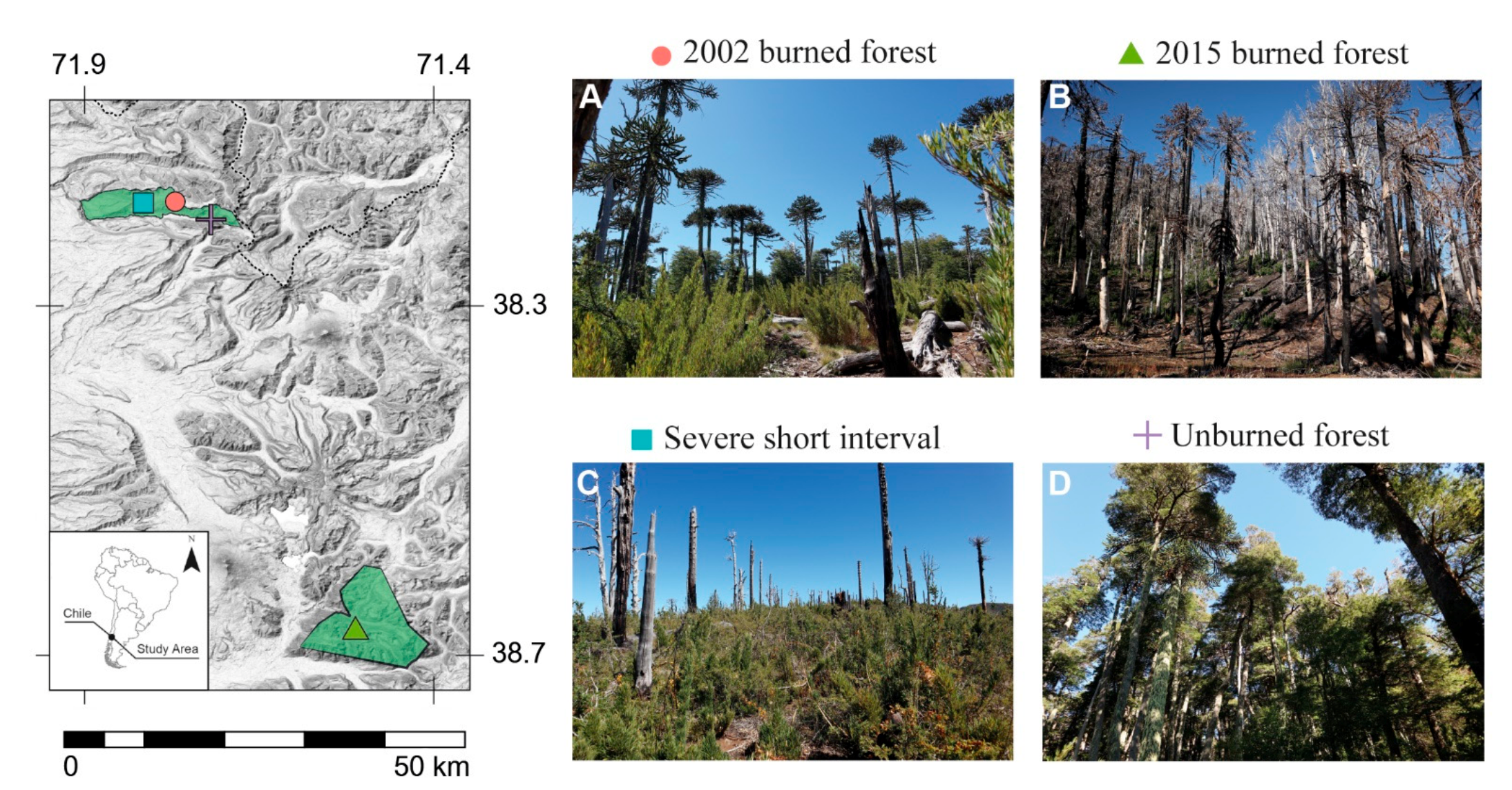
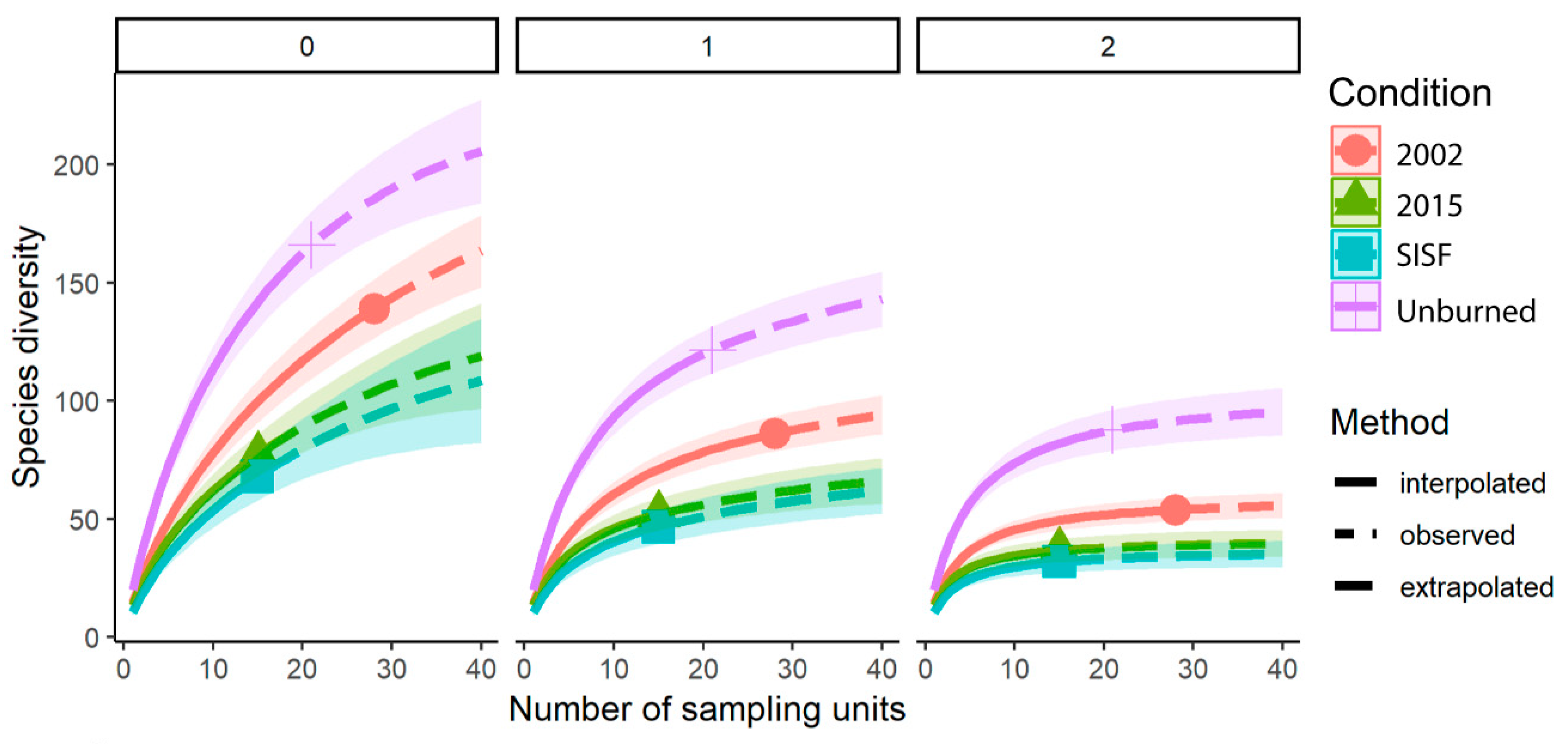
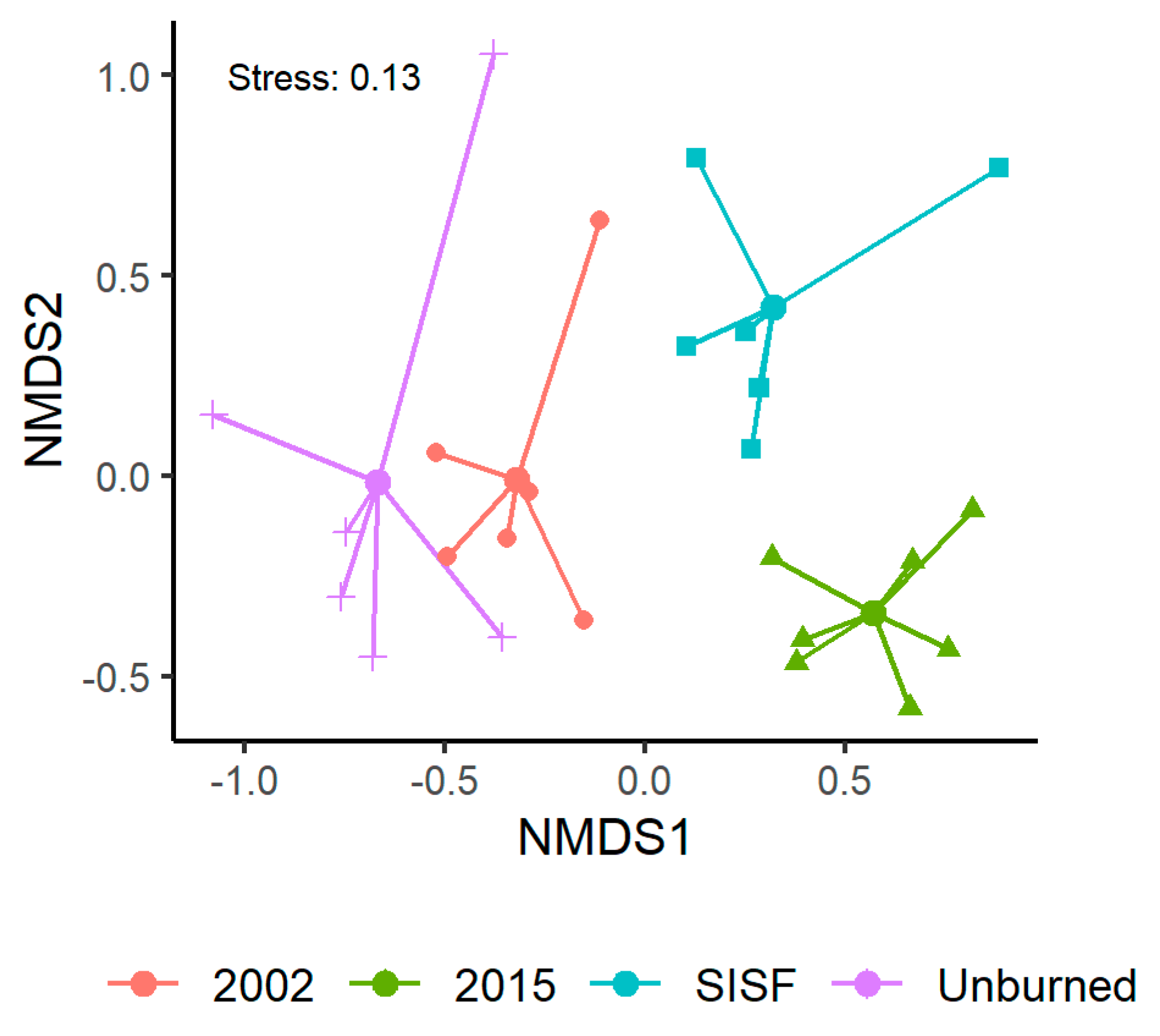
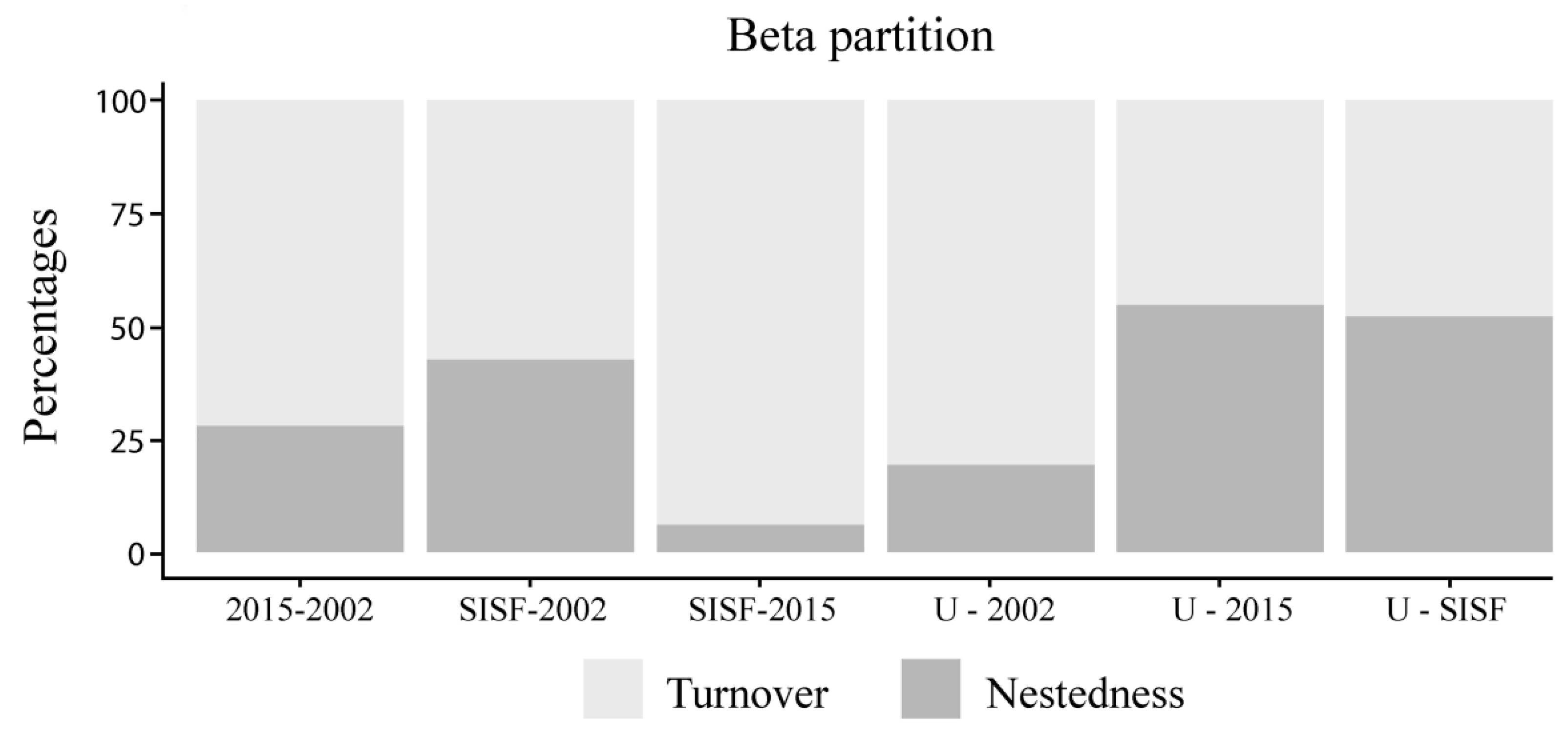
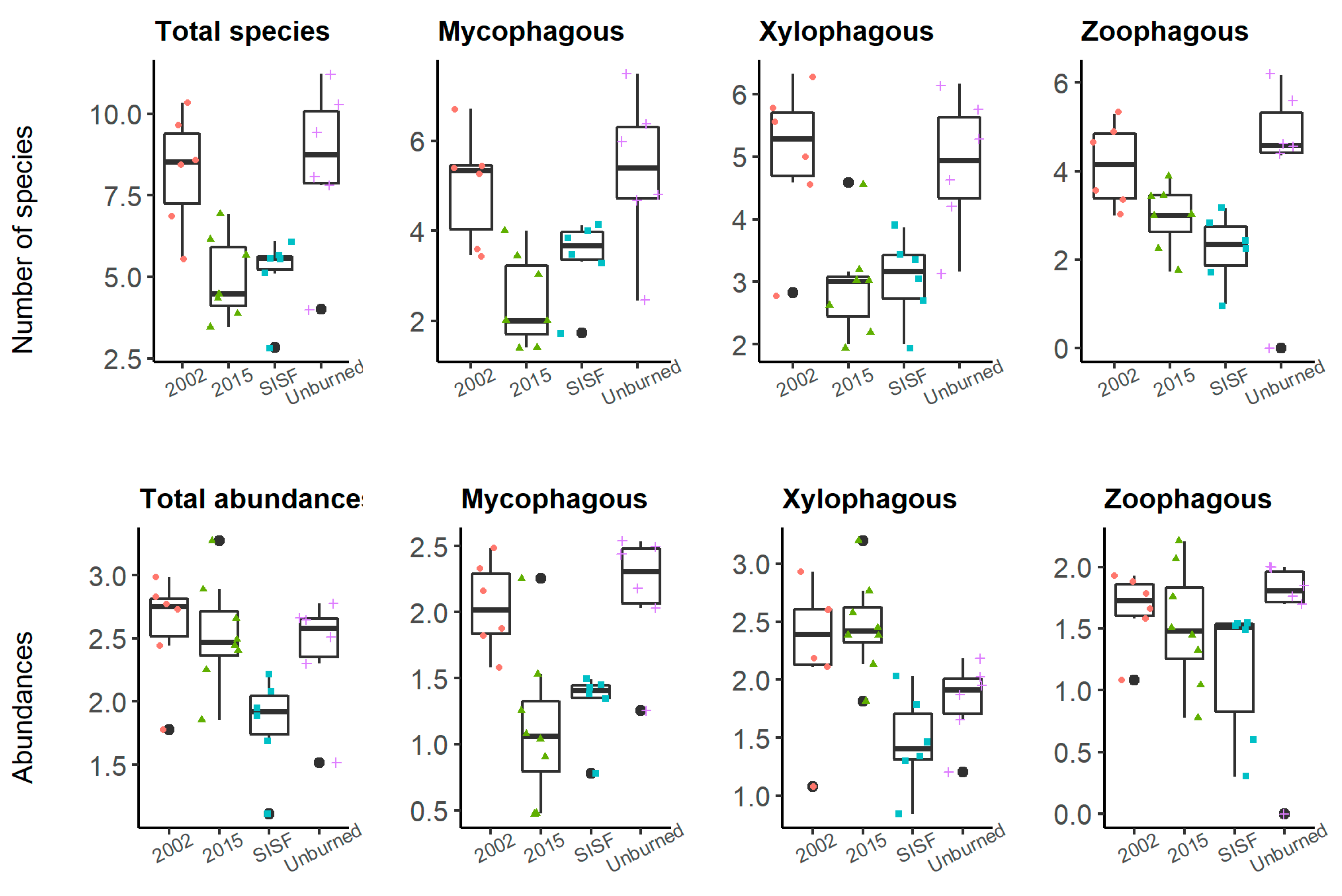
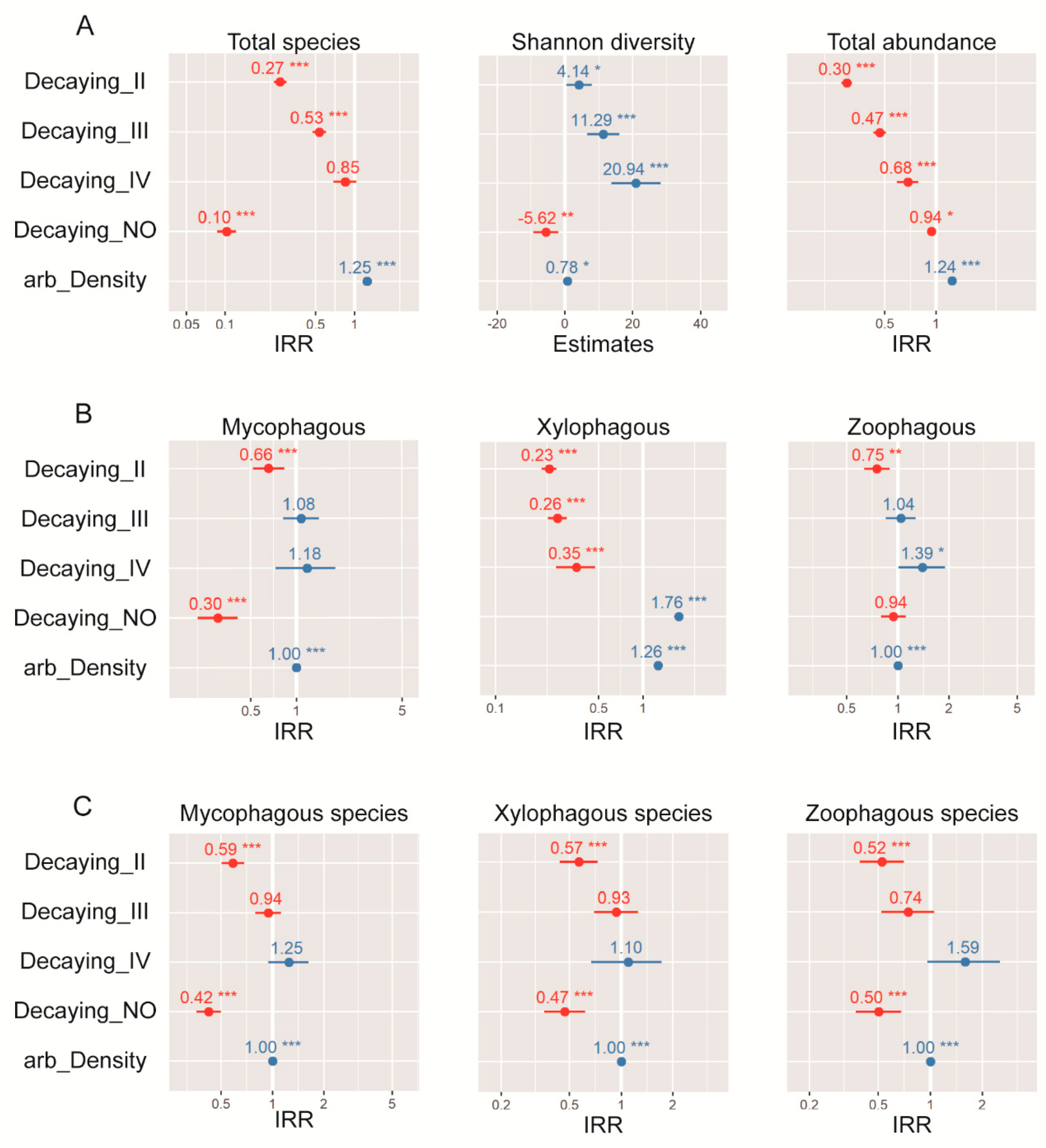
| Character | Decay Class | ||||
|---|---|---|---|---|---|
| 0 | 1 | 2 | 3 | 4 | |
| Leaves | Present | Absent | Absent | Absent | Absent |
| Twigs | Present | Present | Absent | Absent | Absent |
| Bark | Often absent | Often absent | Often absent | Often absent | Absent |
| Bole shape | Round | Round | Round | Round to oval | Oval to flat |
| Wood consistency | Solid | Solid | Semi-Solid | Partly soft | Soft |
| Proprieties | - | - | - | Breakable | Fragmented to powdery |
| Pairs | F | R2 | p-Value | |P| |
|---|---|---|---|---|
| 2002 vs. 2015 | 6.194 | 0.360 | 0.002 | 0.012 |
| 2002 vs. SISF | 3.547 | 0.262 | 0.002 | 0.012 |
| 2002 vs. Unburned | 1.718 | 0.147 | 0.007 | 0.042 |
| 2015 vs. SISF | 4.431 | 0.287 | 0.001 | 0.006 |
| 2015 vs. Unburned | 6.129 | 0.358 | 0.002 | 0.012 |
| SISF vs. Unburned | 3.518 | 0.260 | 0.002 | 0.012 |
| Tukey Test | Number of Species | |||
| Total | Mycophagous | Xylophagous | Zoophagous | |
| 2002–2015 | 0.016 | 0.008 | 0.005 | 0.382 |
| SISF 2002 | 0.028 | 0.165 | 0.011 | 0.079 |
| SISF 2015 | 0.999 | 0.539 | 0.997 | 0.736 |
| Unburned 2002 | 0.996 | 0.972 | 0.994 | 1.000 |
| Unburned 2015 | 0.009 | 0.003 | 0.010 | 0.329 |
| Unburned SISF | 0.017 | 0.073 | 0.020 | 0.064 |
| Tukey Test | Abundances | |||
| Total | Mycophagous | Xylophagous | Zoophagous | |
| 2002–2015 | 0.995 | 0.006 | 0.835 | 0.967 |
| SISF 2002 | 0.025 | 0.047 | 0.035 | 0.439 |
| SISF 2015 | 0.026 | 0.873 | 0.003 | 0.649 |
| Unburned 2002 | 0.874 | 0.972 | 0.381 | 0.988 |
| Unburned 2015 | 0.942 | 0.002 | 0.074 | 0.999 |
| Unburned SISF | 0.117 | 0.018 | 0.562 | 0.629 |
| Response | Models Selection | df | AICc | ΔAICc | Weight | R2 |
|---|---|---|---|---|---|---|
| Total Community | ||||||
| Abundance | Arboreal density + decaying | 6 | 2320.7 | 0.00 | 1 | 0.56 |
| Number of species | Arboreal density + decaying | 6 | 322.4 | 0.00 | 1 | 0.53 |
| “True diversity” | Arboreal density + decaying | 7 | 144.7 | 0.00 | 0.70 | 0.27 |
| Decaying | 6 | 148.2 | 3.42 | 0.13 | 0.23 | |
| Decaying + bark cover | 7 | 148.2 | 3.49 | 0.12 | 0.25 | |
| Trophic guilds abundances | ||||||
| Mycophagous | Arboreal density + decaying | 6 | 912.6 | 0.0 | 1 | 0.71 |
| Xylophagous | Arboreal density + decaying | 6 | 1832.1 | 0.0 | 1 | 0.61 |
| Zoophagous | Arboreal density + decaying | 4 | 679.1 | 0.00 | 0.53 | 0.22 |
| Arboreal density + volume of CWD | 3 | 679.4 | 0.025 | 0.47 | 0.10 | |
| Trophic guilds diversity | ||||||
| Mycophagous | Arboreal density + decaying | 6 | 202.4 | 0.0 | 1 | 0.50 |
| Xylophagous | Arboreal density + decaying | 6 | 206.1 | 0.0 | 0.78 | 0.30 |
| Arboreal density + burn severity | 4 | 208.1 | 2.53 | 0.22 | 0.33 | |
| Zoophagous | Arboreal density + decaying | 6 | 192.8 | 0.00 | 0.98 | 0.37 |
Publisher’s Note: MDPI stays neutral with regard to jurisdictional claims in published maps and institutional affiliations. |
© 2022 by the authors. Licensee MDPI, Basel, Switzerland. This article is an open access article distributed under the terms and conditions of the Creative Commons Attribution (CC BY) license (https://creativecommons.org/licenses/by/4.0/).
Share and Cite
Tello, F.; González, M.E.; Micó, E.; Valdivia, N.; Torres, F.; Lara, A.; García-López, A. Short-Interval, Severe Wildfires Alter Saproxylic Beetle Diversity in Andean Araucaria Forests in Northwest Chilean Patagonia. Forests 2022, 13, 441. https://doi.org/10.3390/f13030441
Tello F, González ME, Micó E, Valdivia N, Torres F, Lara A, García-López A. Short-Interval, Severe Wildfires Alter Saproxylic Beetle Diversity in Andean Araucaria Forests in Northwest Chilean Patagonia. Forests. 2022; 13(3):441. https://doi.org/10.3390/f13030441
Chicago/Turabian StyleTello, Francisco, Mauro E. González, Estefanía Micó, Nelson Valdivia, Fernanda Torres, Antonio Lara, and Alejandra García-López. 2022. "Short-Interval, Severe Wildfires Alter Saproxylic Beetle Diversity in Andean Araucaria Forests in Northwest Chilean Patagonia" Forests 13, no. 3: 441. https://doi.org/10.3390/f13030441
APA StyleTello, F., González, M. E., Micó, E., Valdivia, N., Torres, F., Lara, A., & García-López, A. (2022). Short-Interval, Severe Wildfires Alter Saproxylic Beetle Diversity in Andean Araucaria Forests in Northwest Chilean Patagonia. Forests, 13(3), 441. https://doi.org/10.3390/f13030441






